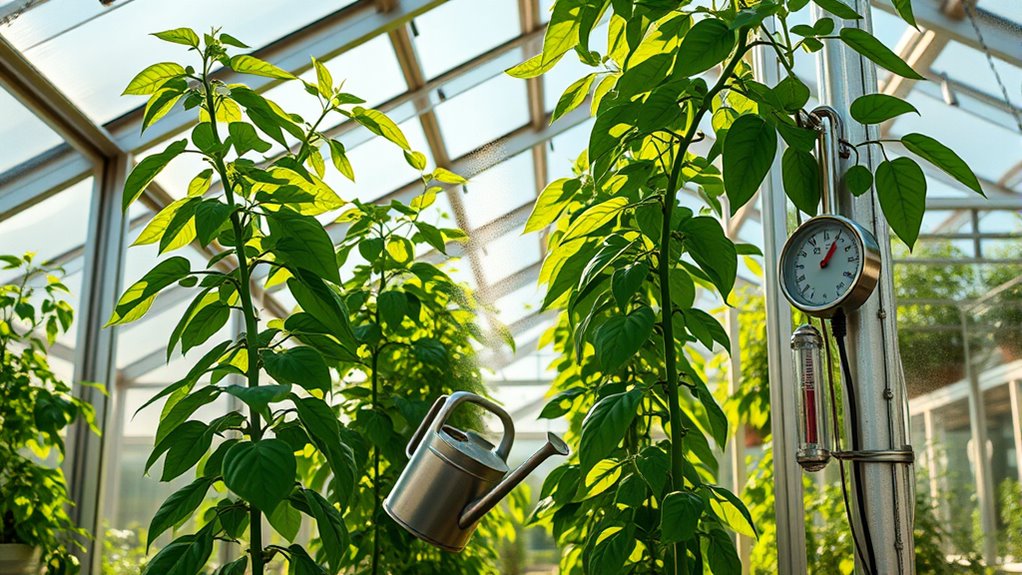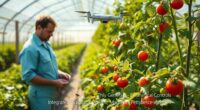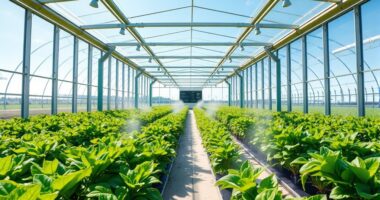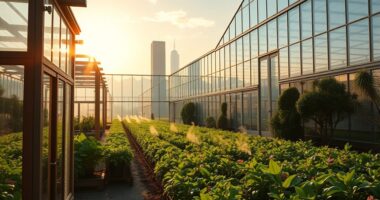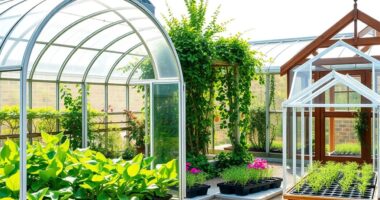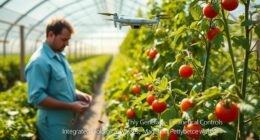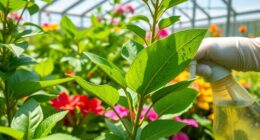A greenhouse works by trapping warmth and light, creating a stable environment for plants to grow all year. It uses transparent walls and a roof to let sunlight in, which heats up the space. The warm air is retained, while proper ventilation prevents overheating and controls humidity. This controlled setting allows you to start seeds early, protect delicate plants, and manage pests effectively. Keep exploring to discover how to optimize your greenhouse’s environment for success.
Key Takeaways
- Greenhouses create a controlled environment by trapping heat and light, enabling year-round plant growth regardless of outdoor weather.
- They utilize environmental controls like heaters, fans, and humidifiers to maintain optimal temperature and humidity for plants.
- Supplemental lighting, such as grow lights, enhances photosynthesis during short days or winter, supporting healthy development.
- Proper ventilation and pest management strategies help prevent mold, mildew, and pest infestations within the greenhouse.
- Overall, greenhouses facilitate plant propagation, protect delicate plants, and extend gardening seasons through regulated conditions.

Greenhouse gardening offers a fantastic way to grow plants year-round, regardless of outdoor weather conditions. When you step into your greenhouse, you’re creating a controlled environment that supports healthy plant growth and extends your gardening season. One of the key benefits of a greenhouse is its ability to facilitate plant propagation. You can start seeds early, root cuttings, and grow delicate plants that might struggle outdoors. With the right conditions—such as consistent warmth, humidity, and light—you can successfully propagate a wide variety of plants, ensuring a steady supply of new growth for your garden. This process allows you to expand your plant collection or share healthy seedlings with friends and family.
Greenhouse gardening enables year-round plant propagation and healthy growth in a controlled environment.
Managing pests inside your greenhouse is also essential to maintaining healthy plants. Unlike outdoor gardens, a greenhouse offers a more controlled setting, making pest management easier when you stay vigilant. Regularly inspecting your plants for signs of pests like aphids, whiteflies, or spider mites helps you catch issues early. You can implement integrated pest management strategies, such as introducing beneficial insects like ladybugs or using organic treatments, to keep pests in check without harming your plants. Ensuring good airflow and cleanliness also reduces pest-friendly environments, preventing infestations from taking hold. By taking proactive steps, you minimize the need for chemical interventions, keeping your greenhouse a safe space for your plants.
Temperature and humidity regulation are essential in creating an ideal environment, particularly for plant propagation and pest control. You might use heaters or fans to keep temperatures consistent, ensuring seeds germinate properly and cuttings root effectively. Humidity levels can be adjusted with misters or ventilation to prevent mold and mildew, which can otherwise harm young plants or encourage pests. These environmental controls contribute directly to your success in propagating plants and keeping pests at bay.
Lighting is another fundamental factor, especially during shorter days or winter months. Supplementing natural light with grow lights can help your plants develop strong roots and healthy foliage. Adequate light also supports photosynthesis, which boosts plant resilience against pests and diseases. The combination of proper lighting, temperature, and humidity creates a thriving ecosystem inside your greenhouse, making plant propagation more successful and pest management more straightforward.
Ultimately, a greenhouse provides you with the tools and environment needed to nurture your plants from seedling to maturity, all while keeping pests under control. With consistent care and attention to environmental conditions, you’ll enjoy a productive, healthy garden year-round.
Frequently Asked Questions
How Do Greenhouses Regulate Temperature Automatically?
Greenhouses automatically regulate temperature through ventilation systems and thermal mass. When it gets too hot, your ventilation system opens vents to release excess heat, cooling the space efficiently. Thermal mass, like water barrels or stone walls, absorbs heat during the day and releases it at night, maintaining a stable temperature. This combination helps your greenhouse stay warm or cool as needed, creating a suitable environment for your plants to thrive.
Can Greenhouses Be Used for Year-Round Gardening?
Yes, you can use a greenhouse for year-round gardening if you manage plant selection and pest control carefully. During colder months, you’ll need to supplement with heating and proper insulation. Choose hardy, suitable plants for each season, and keep pests in check through integrated pest management techniques. With proper planning, your greenhouse can provide a consistent environment, allowing you to enjoy fresh produce and vibrant plants year-round.
What Are the Best Materials for Greenhouse Coverings?
When choosing covering materials, you want options that offer great greenhouse durability and ideal light transmission. Polycarbonate panels are a top choice because they’re strong, impact-resistant, and provide excellent insulation. Glass is another excellent material, offering durability and clarity, though it can be more fragile and expensive. Polyethylene film is affordable and lightweight but less durable over time. Selecting the right covering depends on your climate and budget, ensuring your greenhouse stays protected year-round.
How Does Humidity Control Work in Greenhouses?
Humidity control in your greenhouse relies on ventilation systems and humidity sensors. When sensors detect high humidity levels, they trigger ventilation fans to exchange moist air with drier outside air, reducing excess moisture. Conversely, if humidity drops too low, you can manually adjust vents or add misting systems. Regularly monitoring with sensors guarantees ideal humidity, promoting healthy plant growth and preventing mold or disease.
Are Greenhouses Energy-Efficient for Large-Scale Farming?
Imagine a vast, sunlit glass dome basking in golden rays, efficiently trapping warmth with minimal waste. You’ll find that greenhouses can be quite energy-efficient for large-scale farming when equipped with solar panels to harness sunlight and water recycling systems to reduce waste. These features lower energy costs and environmental impact, making greenhouses a sustainable choice. With smart design, they become productive, eco-friendly ecosystems supporting sustainable agriculture on a grand scale.
Conclusion
Now that you understand how greenhouses work, you’re like a modern-day Daedalus, crafting a sanctuary for your plants. With this knowledge, you can create a thriving oasis regardless of the weather outside. Just remember, your greenhouse is your own little Eden—your personal Garden of Hesperides. So go ahead, harness the sun’s power, nurture your plants, and enjoy the lush rewards of your newfound gardening mastery. The green thumb is yours to cultivate!
